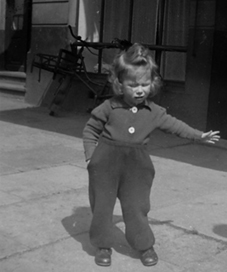Search for Names, Places and Biographies
Already layed Stumbling Stones
Suche
Elke Pünner * 1935
Marckmannstraße 135 (Hamburg-Mitte, Rothenburgsort)
ELKE PÜNNER
GEB. 6.8.1935
ERMORDET 5.2.1943
further stumbling stones in Marckmannstraße 135:
Dr. Carl Stamm
Elke Pünner, born on 6 Sept. 1935 in Barmstedt/Holstein, died on 5 Feb. 1943 in Hamburg
Marckmannstrasse 135, former children’s hospital
Elke Pünner comes from a long-established family in the Holstein town of Barmstedt. She was born there on 6 Aug. 1935 and baptized in the Lutheran Church.
Her parents, the carpenter Walter Pünner and his wife Marie, née Maurer, moved in 1936 to Hamburg-Rothenburgsort, where they took over the dairy business from a widow by the name of Pflug, which her husband had opened in 1934. This was a shop with an adjoining apartment in the basement of Billwärder Neuedeich 267, next to the premises of hairdresser Hermann Meyer. The nearest streets were Lindleystrasse in the east, which led directly to St. Thomas Church, and Billhorner Mühlenweg in the west.
Elke’s siblings Elisabeth (1937), Klaus-Jürgen (1938), and Heiner (1940) were born in Rothenburgsort in the maternity ward of the children’s hospital at Marckmannstrasse. They were baptized in St. Thomas Church. Since the parents were both working in the business, they hired a nanny.
According to her siblings, Elke was born with an eye disease, more specifically, cataracts. Before the anterior fontanelle was closed, her brain was punctured. The reasons for this are not known, nor in which hospital the operation was performed. However, it resulted in a malposition of the right foot. Elke developed paralysis on the right side, which, however, just like her visual impairment, did not prevent her from playing with other children in the Traunspark or in front of the house. It is not known whether she was sent to school according to her age.
Elke’s father was drafted into the German Wehrmacht in 1942.
The date Elke was admitted to the children’s hospital in Rothenburgsort cannot be traced. (A death certificate that could have contained relevant information was not available in the Hamburg State Archives, since such certificates were kept or archived for military personnel only from 1943 onward. In addition, all death certificates were destroyed in the summer of 2018).
Elke Pünner’s patient file and the family papers were lost during the extensive destruction of the children’s hospital by air raids during the firestorm in July 1943. Thus, no more details can be established about her state of health and treatment.
It is possible that the chief physician Wilhelm Bayer could have fallen back on Elke Pünner’s earlier medical file, regardless of where she had been operated on, in order to make a diagnosis along the lines of the formal procedure associated with the "Reich Committee” ("Reichsausschuss-Verfahren”) and to venture a prognosis whether a child should be killed or not. Whether he initiated such a regular procedure cannot be checked, because all documents of the Hamburg Health Office concerning the "Reich Committee Procedure” were also destroyed in July 1943, and in Berlin all documents concerning the "Reich Committee Procedure” were deliberately destroyed by those responsible or were lost due to the war.
In the register of deaths, which has been preserved, three causes of death are listed: "Cerebral damage” as the main ailment. This was one of the usual conventions of speech at the children’s hospital in Rothenburgsort for one or more of the notifiable conditions, which emerges from a comparison with the existing death certificates and other death register entries. Notifiable conditions were "idiocy” (such as Down Syndrome), small head, hydrocephalus, severe deformities, and paralysis. Paralysis of the right side was provided as "concomitant and subsequent illnesses,” which were usually given as reasons for hospitalization, and "circulatory weakness” as the acute cause of death. "Circulatory weakness,” a harmless term, was often used in connection with fatal pneumonia, intentionally induced by high-dose administration of Phenobarbital (Luminal).
Family tradition has it that Elke died during an epileptic seizure, which is not in direct contradiction to the official statements. On 8 Feb. 1943, the mother reported Elke’s death to the Rothenburg records office.
Despite all the cover-up, she doubted the natural death of her daughter. The parents had Elke cremated and the urn buried in the family grave in Barmstedt. In 2017, the grave was removed. Elke Pünner reached the age of seven and a half years.
Translator: Erwin Fink
Kindly supported by the Hermann Reemtsma Stiftung, Hamburg.
Stand: July 2020
© Hildegard Thevs
Quellen: Hamburger Adressbücher, StaH 332-5, 1187/103/1943, StA 4b (Sterberegister), St. Thomas-Kirche Rothenburgsort, Taufregister 1937, 1938, 1940; Mitteilungen von Angehörigen 2018 f.


